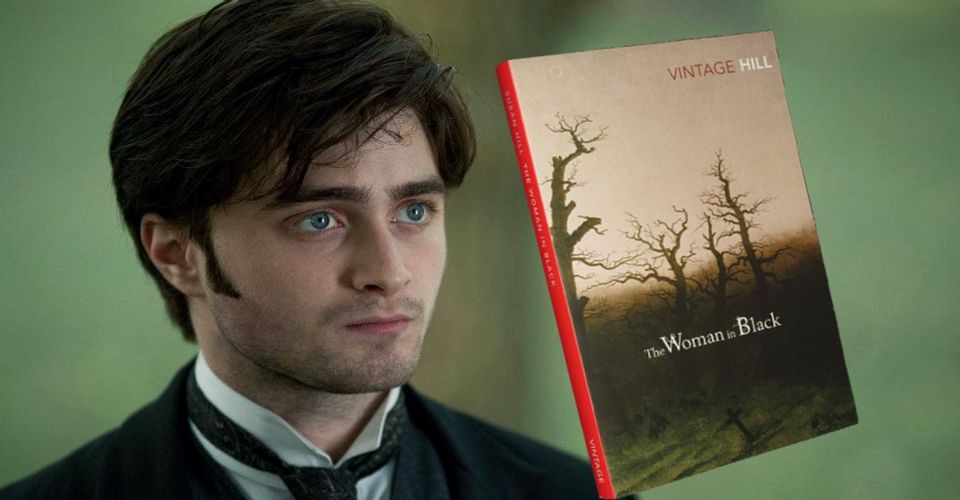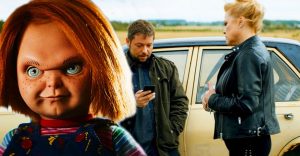The Woman In Black: The Biggest Differences Between The Book And Movie

The 2012 supernatural horror film The Woman in Black occasionally deviates from the 1983 Susan Hill novel that it’s based on. The general story follows Arthur Kipps, a young lawyer who travels to an isolated village called Crythin Gifford for work. During his stay there, he discovers that the evil spirit of a scorned woman is terrorizing the local people.
The movie, directed by James Watkins and written by Jane Goldman, stars Daniel Radcliffe as Arthur. Radcliffe’s performance garnered him positive reviews from critics, and the movie was also praised for its cinematography and direction. Overall, the film was a commercial success, though its 2015 sequel—not involving Radcliffe, Watkins, or Goldman—was ultimately panned.
The original story of The Woman in Black was in the form of a gothic novel written by English author Susan Hill. The book was adapted into a play in 1987 — the second longest-running one on the West End. It was also made into a television film in 1989, though Hill publicly disagreed with the changes the screenwriter Nigel Kneale made in adapting her story. With the 2012 movie, though, Hill helped screenwriter Jon Croker with his movie adaptation. Despite this, the movie did occasionally deviate from its source material. Here’s every change the 2012 movie made to its original source material.
Arthur’s Reason For Traveling To Eel Marsh

In the book The Woman in Black, Arthur is a new lawyer trying to prove his worth to the company he works for. He does so by going to the Eel Marsh estate in the village of Crythin Gifford to finalize the affairs of a recently deceased woman, Alice Drablow. In the book, Arthur’s reason for traveling to Eel Marsh is that he’s in danger of losing his job and has to redeem himself.
Arthur’s Familial Status

The book states that Arthur has a fiancée at the time that he starts his travels. Toward the very end of the story, she becomes his wife and the two have a son. The movie starts out differently. In the movie, Arthur is newly widowed and has a four-year-old son from the get-go. This alteration deeply affected the movie, as it turned Arthur’s character into a grieving widower and single father.
The Locals

The local townspeople in The Woman in Black book are different from the ones in the movie adaptation. In the book, they overall ignore Arthur’s presence, avoiding him and drawing away from potential interactions with him. In the film, though, the locals play a more prominent role. They are outright dismissive of Arthur, even bullying him and demanding he leave Crythin Gifford at several points. They also blame him as deaths keep occurring in the village.
The Adoption Story

In the movie, Arthur discovers letter suggesting that the character Alice Drablow—the deceased owner of the Eel Marsh house—orchestrated her adoption of her sister Jennet’s son, Nathanial. Through the papers he finds, Arthur can tell that Alice and Jennet had a tense rivalry over this. In the book, this isn’t the case. Instead, it’s stated that Alice adopted Jennet’s son, but it wasn’t her idea. Instead, she was approached about it and took on the responsibility. In the movie, meanwhile, Alice refers to Jennet as unstable in her letters, and as mentally unfit to care for Nathanial.
Jennet (the Woman in Black)

The overall character of Jennet, Alice’s sister—the titular Woman in Black—is portrayed differently in the movie than she is in the book. In the book, her cruel actions are explained — they’re all driven by the grief she holds for her lost son. In the movie, her backstory is never fully revealed, so viewers are overall unable to sympathize with her. Also in the book, it’s stated that Jennet had developed a disease and died of complications from it. In the movie, though, she’s said to have committed suicide by hanging herself.
The Woman In Black’s Ending

At the ending of the movie, Arthur must race to save the life of his son, believing that the Woman in Black is going to kill him once he gets to Crythin Gifford. In the book, though, Arthur’s son is not a part of the story at that point. At the very end of the movie, Arthur’s son and nanny arrive. Arthur’s son steps out onto the train tracks, and as Arthur rushes out to save him, they are both hit by a train and killed. Arthur’s deceased wife appears as a woman in white, leading them away.
In the book, after the events at Crythin Gifford come to an end, Arthur travels back to London, leading readers to believe that he’s broken the curse of the Woman in Black. He marries his fiancée and they have a son. However, Arthur watches his wife and son die in an accident reminiscent of the death of Nathanial. The shock of their deaths at the end of the book is horrifying, and even more of a twist than the train ending in the movie. Plus, this ending suggests that Arthur must live the rest of his life alone in grief.
Other Changes In The Woman In Black

In The Woman in Black movie, there are also some smaller, almost unnoticeable changes from the book. For example, Mr. Jerome, the local solicitor, has a much bigger role in the book. Samuel Daily, a local landowner, meanwhile, has a bigger role in the film. And in the movie, Arthur seeks out Nathanial’s body in the marsh, finding it and giving him a proper burial. In the book, though, this doesn’t happen — instead, Nathanial’s body remains lost in the marsh forever.
Something the movie doesn’t show is the funeral scene. In the book, it’s a tense, suspenseful moment in which Arthur first glimpses the Woman in Black. In the movie, though, this scene is completely missing. The movie also fails to show the physical illness that Arthur is overcome with in the book; he becomes sick due to the horrifying events he experiences at the Eel Marsh house. While the 2012 movie version of The Woman in Black did indeed make changes—both big and small—to the original version of the story, it’s overall loyal to Hill’s ultimate vision of Arthur Kipps and the tragic events that happen in Crythin Gifford.
About The Author

















